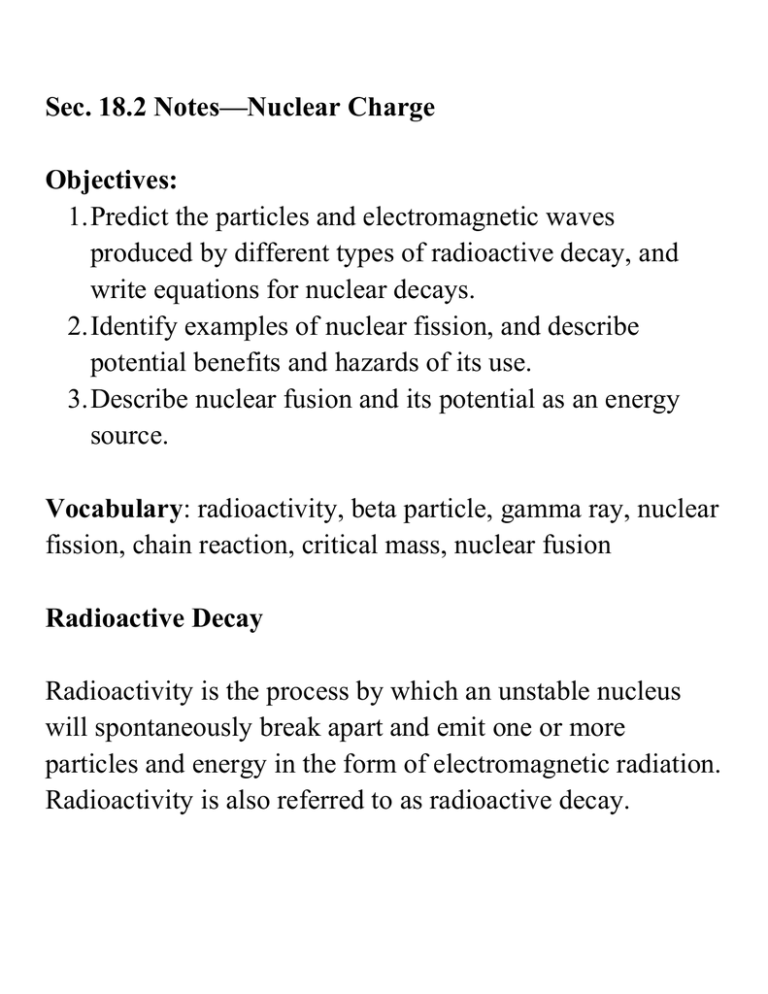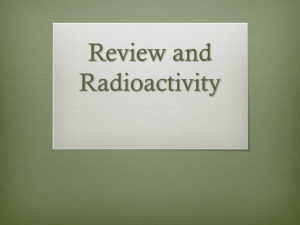Section 18.2: Nuclear Charge
advertisement

Sec. 18.2 Notes—Nuclear Charge Objectives: 1. Predict the particles and electromagnetic waves produced by different types of radioactive decay, and write equations for nuclear decays. 2. Identify examples of nuclear fission, and describe potential benefits and hazards of its use. 3. Describe nuclear fusion and its potential as an energy source. Vocabulary: radioactivity, beta particle, gamma ray, nuclear fission, chain reaction, critical mass, nuclear fusion Radioactive Decay Radioactivity is the process by which an unstable nucleus will spontaneously break apart and emit one or more particles and energy in the form of electromagnetic radiation. Radioactivity is also referred to as radioactive decay. Stabilizing Nuclei by Converting Neutrons into Protons If a particular isotope has too many neutrons (large N/Z ratio), the nucleus will decay and emit radiation. A neutron may decay and emit a high-energy electron called a beta particle (β particle). 1 0𝑛 → 1 +1𝑝 + 0 −1𝑒 or 1 0𝑛 → 1 +1𝑝 + 𝛽 Because this process changes a neutron into a proton, the atomic number of the nucleus increases by one and the product becomes a different element. The mass number does not change. 14 6𝐶 → 14 7𝑁 + 0 −1𝑒 Stabilizing Nuclei by converting Protons into Neutrons An element that is unstable due to too many protons can become more stable by converting protons into neutrons through a process called electron capture. In this process gamma rays (Greek symbol γ) are released. 1 +1𝑝 + 0 −1𝑒 → 10𝑛 + 𝛾 In this process, the unstable nucleus loses a proton and becomes the element with the next lower atomic number. The mass number does not change. 51 24𝐶𝑟 + 0 −1𝑒 → 51 23𝑉 + 𝛾 Stabilizing Nuclei by Positron Emission 1 +1𝑝 → 10𝑛 + 0 +1𝑒 When a proton changes into a neutron and emits a positron, the atomic number decreases by one but the mass number remains the same. 51 24𝐶𝑟 → 49 23𝑉 + 0 +1𝑒 The positron is the opposite or antiparticle of an electron. Once created, a positron will instantly collide with an electron, in a process called annihilation of matter, to create gamma ray. 0 +1𝑒 + 0 −1𝑒 → 2𝛾 Gamma rays from electron-positron annihilation have characteristic wavelength that can be used to identify nuclei that decay by positron emission. Such gamma radiation has been detected coming from the center of the Milky Way galaxy. Stabilizing Nuclei by Losing Alpha Particles An unstable nucleus that has an N/Z number that is much larger than 1 can decay by emitting an alpha particle. 238 92𝑈 → 234 90𝑇ℎ + 42𝐻𝑒 No elements with atomic numbers greater than 83 or mass numbers greater than 209 are stable, and many of these unstable become stable through alpha decay. Many heavy nuclei go through a series of reactions called a series before they reach a stable state. Uranium-238 decays to lead-206 through a decay series that includes alpha and beta decay. Each isotope in the decay series has a specific half-life that determines how long it exists before it decays to something else. Eventually, uranium-238 decays to the stable isotope lead-206 in a process that takes millions of years. Notice that when writing nuclear equations the sum of the mass numbers (superscripts) on one side always equals the sum on the other side. The same holds true for the atomic numbers (subscripts). Remember that, when the atomic number changes, the identity of the element changes. Nuclear Fission Radioactivity can be of two types: natural radioactivity (occurring in nature) or induced or artificial radioactivity (brought about by particle bombardment). The reactions studied so far in which the nucleus decays by adding or losing particles are natural radioactivity. Nuclear fission occurs when the nucleus splits into two or more fragments in a process that produces additional neutrons and a lot of energy. Most fission reactions happen artificially or are induced by bombarding nuclei with neutrons. The following equation and figure show what happens when a uranium-235 isotope is bombarded with a neutron. The reaction produces two or three neutrons. Each of these neutrons can then cause the fission of another uranium-235 nucleus. If this is allowed to continue, a process called a chain reaction can occur. A characteristic of a chain reaction is that the particle that starts the reaction—in this case a neutron—is also produced from the reaction. A minimum quantity of radioactive material, called a critical mass, is needed to keep the chain reaction going. 235 92𝑈 → 93 36𝐾𝑟 + 140 56𝐵𝑎 + 3 10𝑛 Chain reactions Occur in Nuclear Reactors Fission reactions are used to generate electrical energy in nuclear power plants. Fission reactions produce a lot of energy: 1 gram of uranium-235 can generate as much energy as the combustion of 2700 kg of coal. Uranium-235 and plutonium-239 are the main radioactive isotopes used in these reactors. In a nuclear reactor core, the fuel rods are surrounded by a moderator, a substance that slows down neutrons. Control rods. Made from cadmium, the control rods are used to adjust the rate of the chain reactions. They can absorb some of the free neutrons produced by fission, and moving them in or out of the core can slow or speed up the reaction. As shown in the figure, water is heated by the energy released from the controlled fission. This water turns to steam and the pressurized steam drives a turbine to produce electrical energy. Therefore, a nuclear power plant is very similar to a coal fired power plant. All that is different is the source of heat used to heat the water. Nuclear Fusion Nuclear fusion occurs when small nuclei combine, or fuse, to form a larger, more stable nucleus. In the process, mass is converted into a large amount of energy is release as the new nucleus forms. Fusion releases greater amounts of energy than fission. Fusion powers stars, like our Sun. Four hydrogen nuclei fuse to form a single helium-4 nucleus. 4 11𝐻 → 42𝐻𝑒 + 2 +10𝑒 + 𝑒𝑛𝑒𝑟𝑔𝑦 Very high temperatures are needed to bring the nuclei together. The temperature of the sun’s core, where some of the fusion occurs, is about 1.5 x 107 oC (or 15 million degrees centigrade).






